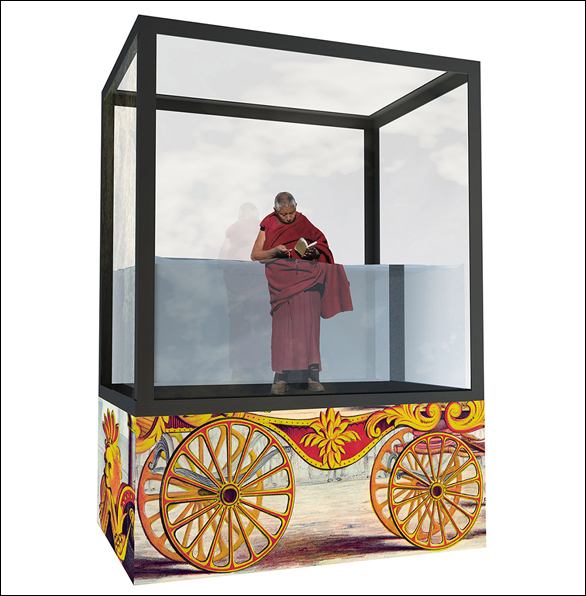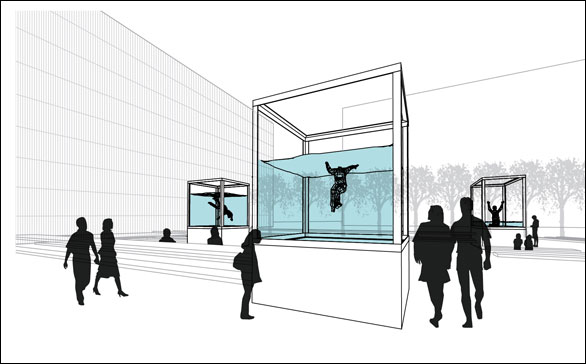
A concept sketch of a HOLOSCENES aquarium. Image: Peter Zuspan / Lars Jan
TED Fellow Lars Jan, the director of the multi-disciplinary art lab Early Morning Opera, is seeking everyday personal rituals from collaborators — perhaps, you? — for a work-in-progress called HOLOSCENES. This public-performance installation — inspired by humanity’s relationship with climate change and flooding — will be made up of three aquariums, each enclosing a performer enacting a looped, choreographed ritual as water rises and falls driven by environmental data drawn from the internet.
Would you like to contribute? Read on.
Can you give us an example of the kinds of rituals you’re collecting?
We had a collaborator on the border of Myanmar who met a family and documented a daily face-painting ritual. It’s for beautification, but it also acts as a sunblock. It involves a kind of wood called thanaka, which is ground on a particular kind of stone with a little bit of water to form a paste, which is applied on the face. This ritual is mostly done by women, who also apply it to their children, often in beautiful patterns. This particular woman used a toothbrush to apply it every morning. That’s the thing that’s important — the ritual might be something that happens in hundreds of thousands of households, but the point of the project is not to recreate the ritual in a generic fashion. We’re making contact with very specific individuals who perform their own ritual in a very specific way. I make coffee in the morning like a lot of people, but I also have my own idiosyncrasies — a personal pattern to this daily ritual that is all my own.
Will the rituals you’re collecting form the basis of the performances inside the aquariums?
Yes. The choreography and design of the physical behaviors inside the aquariums are all sourced from people we make contact with who live near any one of the 52 coordinates that we generated randomly across the globe. Our performers simulate these rituals inside the aquariums based on documentation collected by collaborators. Sometimes the people we’re contacting are far away – I’m communicating with people who are, say, in Uganda, having been handed from one interested person to another to another to reach people who are close to a coordinate and want to collaborate with us. What I wanted to do was to create a semi-open source network, dependent on an unpredictable cascade of online and in-person encounters.

A rendering of what HOLOSCENES will look like when staged. Credit: Peter Zuspan
Will the contributors get to participate in performances?
Yes, by providing the source material for the choreography and design at the heart of the project.
The entire collection process is actually referencing 500 years of what could be called a colonialist collection process, starting with imperial menageries, cabinets of wonder or curiosity, down to zoos and world’s fairs and aquariums. And we want to depriortize catastrophe as a lens through which to look at the world.
The project is inspired by flooding. In the last decade, I’ve found myself looking at a lot of places I had never seen before, and the reason I was looking at them, by way of beautiful photographs online and in newspapers, was because they were devastated. I wanted to find a more democratic way to look at the planet and the people on it. Rather than highlight people at the extremes, at their lowest, I wanted to cultivate and collect the mundane — and sacred — everyday behaviors of people across the planet.
How do the rituals then relate to climate change and flooding?
That’s partly where the conceptual and aesthetic leap is. Ultimately, the project is putting the rhythms of daily behaviors and human-scale patterns in conversation with longer-term patterns, such as those driving climate change. That’s a question at the heart of the project: What’s the future of long-term thinking? Are we, as individuals, communities, and a global society, capable of evolution in terms of recognizing complex, long-term patterns and then adapting our everyday behaviors based on that rational understanding?
The aquariums flood and drain with water at varying speeds. What drives the hydraulic system to make water going up and down in the tanks is environmental data scraped from the internet and other sources. Sometimes it floods incredibly slowly, sometimes very quickly. It’s a material data visualization: the water level goes up and down, but rather than seeing it from a remove, the data driving the water movement flooding and draining is dramatically affecting the ritual being performed, and dramatically changing the environment of the person in the tank. I’m curious to see the visceral empathic response viewers will have seeing the water flooding and draining, flooding and draining while a person — a performer — copes with the very mythic yet increasingly present-tense condition of deluge.
This visceral, visual metaphor — a person fighting through flood in an aquariam — is partly about our collective myopia in the face of these changes and our persistence and adaptive capacities in response to our changing environment — a multi pronged, complex visual metaphor that radiates out and connects with all kinds research and thinking, from behavioral science, climate science and palaeontology to questions like “What’s the neurology of long-term thinking? What’s the evolutionary future of empathy in an increasingly mediated world?” All those things are woven together in the project.
Where will HOLOSCENES be performed?
The full public, three-aquarium iteration of HOLOSCENES will premiere at the Yerba Buena Center of the Arts in San Francisco in 2015, and likely premiere in a one-aquarium iteration sometime in 2014. Ultimately, it is meant to be a public performance intervention in an urban environment, running 24-hours a day for 7 days. The intention is to become a pivot for a public discourse and awareness outside of an exclusively artistic context. My collaborators and I are interested in reaching a far broader audience.
To find out more and contribute a ritual to be considered for HOLOSCENES, visit the website »
Comments (2)
Pingback: Lars Jan’s HOLOSCENE’s project makes waves | TEDFellows Blog
Pingback: Wizmo Blog » Blog Archive » Daily rituals performed in a flood: A TED Fellow is crowdsourcing rituals for a unique performance